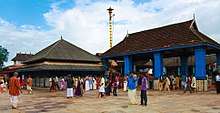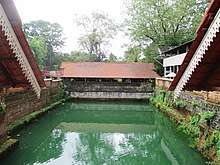Chottanikkara Temple
The Chottanikkara (correction of Jyotiannakkara) Devi Temple is a famous temple of mother goddess Bhagavati. She is a form of Mahalakshmi. Lakshmi is believed to be residing in Chottanikkara along with the supreme deity lord Maha Vishnu. The temple is located at Chottanikkara, a southern suburb of the city of Kochi in the state of Kerala, India and is one of the most popular temples in the state. In terms of temple architecture, Chottanikkara temple stands out to be an ultimate testimonial for the ancient vishwakarma sthapathis (wooden sculpture) along with Sabarimala temple. Sree Mahamaya Bhagavati (Adi Parashakti), the goddess of saraswati, Lakshmi and Parvati is one of the most popular deities in Kerala and the supreme mother goddess in Hinduism. Chottanikkara Devi (Melekavu Bhagavathi) is worshipped at the temple, in three different forms: as Mahasaraswati in the morning, draped in white; Mahalakshmi at noon, draped in crimson; and as Mahakali in the evening, decked in blue. Goddess 'Keezhkkaavu bhagavathi' is believed to be Bhadrakali, in her fierce form or Ugra form. Bhadrakali, is a form of mother Kali, supposed to be born from the third eye of lord Shiva, to kill the demon king Darika. People suffering from mental illnesses and commonly visit the temple, as Chottanikkara devi is said to cure her devotees. Guruthi pooja is a ritual done at late evening to invoke goddess Mahakali. Earlier 'Guruthi Pooja' was done only on Fridays. But nowadays, it is performed every day.
| Chottanikkara Temple | |
|---|---|
Chottanikkara Bhagavathy Temple | |
 Chottanikkara Temple | |
| Religion | |
| Affiliation | Hinduism |
| Deity | Chottanikkara Devi (Chottanikkara Amma) Mahalakshmi |
| Festivals | Makam Thozhal |
| Location | |
| Location | Chottanikkara |
| State | Kerala |
| Country | India |
 Location in Kerala | |
| Geographic coordinates | 9.933°N 76.391°E |
Legend
The area in which the temple is situated was once a dense jungle that is to said to be infested by yakshis and raktharakshas. A tribesman named Kannappan used to live in this forest. He was a devout worshipper of Kali, and would ritually sacrifice a cow to her every Friday (the day of the Goddess). One day, he found a beautiful black calf near the forest. He kidnapped the calf and took her to his altar. Just before he sacrificed the calf, tribesman's daughter Manimanga stepped in and pleaded to him to stop the sacrifice. The man loved his daughter and thus let her keep the calf as a pet. Unfortunately, Manimanga died some days later, possibly due to a snake bite. Kannappan broke into tears and decided to cremate her body. To his surprise, his daughter's corpse disappeared. A nearby priest told him the reason for such an occurrence; Kannappan used to forcibly take young calves from their mothers and sacrificed them. As punishment, he met the same fate when his daughter died. However, when the tribes man looked for the calf, he found two divine stones in its place. The priest again tells him that the stones were actually divine and that they represented the divine couple, Vishnu and Lakshmi, and to pray before these stones everyday and he would be forgiven for what he had done in the past.
Since Kannappan's death, the stones were forgotten. One day, a grass-cutter came to the forest to cut some wild grass. Since her knife was blunt, she sharpened it on what she thought was a big stone. Only it was a stone, but then it started bleeding. Horrified at what she saw, she brought the matter to the public's attention. A nearby priest was called to solve the problem. After devaprasnam, it was concluded that the stones were divine.
Another legend associated to the temple was that of the spiritual leader Shankaracharya. During the time where he lived, Adi Shankara realised that there wasn't a single temple in Kerala that signified the worship of goddess Lakshmi. As a result, he himself went to the Kodachadri hills in Karnataka and meditated for many days for the goddess to appear before him. His meditation bore fruit and before him stood the stunningly beautiful goddess, clad in red. On enquiry, he said that he would like to bring the goddess to Kerala and establish a temple dedicated to her worship. This way the people from Kerala would not have to go such far off distances to worship her, as in the case for those who were old and aged. After a lot of persuasion, the goddess agreed; she would follow him by foot wherever he went, but only on one condition. If he trusts her, then he was not allowed to look back to see if she followed him or not. If he did, then wouldn't go any further. He agrees and they proceed walking. They were walking down the Kodachadri hills, with Shankara leading the way and goddess' anklets tinkling and letting him know that she was with him. After walking some distance, the tinkling stopped all of a sudden. Shankara waited a few moments and stole a quick look backwards to find the goddess still with him, watching him with reproach. In keeping with the condition, the goddess stopped right there. This is the spot which would turn out to be the Mookambika temple. Shankara, however, was not one to give up. He apologized profusely for breaking the condition and repeatedly begged and pleaded with the goddess to go with him to Kerala. After many pleas, the goddess agrees to a compromise and came to Chottanikara in Kerala, where the Chottanikara temple stood.
From early hours of morning, goddess would come and appear before the devotees at the Chottanikkara temple. Then in the afternoon, she would return to the Mookambika temple (spot where she stopped). Since then, the sanctum doors of the Chottanikkara temple were opened during early morning hours in honour of worshipping goddess Saraswati before the doors of the main sanctum in Mookambika temple were opened.
Legend behind Keezhkavu
The idol at Keezhkavu didn't come until after the temple was built. One night, a Brahmin was walking along a moonlit trail. Suddenly, he saw a beautiful woman, standing all alone. He offered to escort her home, and she agreed. On the way, he had to stop by a priest's house to whom he had to return a holy manuscript. Reluctantly, the woman agreed to wait for him outside the house. But when the priest enquired the Brahmin as to who had accompanied him at such odd hours of night, he tells the priest that a woman followed him. Sensing danger, the priest warns him that the woman could be a Yakshi. The helpless Brahmin asks the priest for help, to which the priest gives some holy stones and says that whenever he felt that the woman was near him, he had to throw the stone at the woman without turning back. This would slow her down and further increase the distance from him. Using these stones the Brahmin had to reach the chottanikkara temple lest the yakshi would not harm him. The Brahmin does so accordingly, but as he reached the steps of the temple's sanctum, the woman held him down and transformed into her true form; a blood thirsty vampire. The Brahmin calls for help, to which goddess Parvati appeared and transformed into Mahakali, an aspect representing her anger. She subdues the vampire and kills her. The goddess then went to wash herself in the pond, where the Kali idol was found hundreds of years later by Vilwamangalam of Guruvayoor.
Makam Thozhal

The annual Chottanikkara Makam Thozhal is the major festival in Chottanikara temple. It is believed that it was on this day (mithuna lagna on Makam) that the Vilvumangala Swamiyar saw the goddess at the temple and the devotees worship the goddess at this time.[1]
On the Makam Thozhal day, the ritualistic bath of godess in the morning at the sacred pond Calli Onakkuttichira far on the northern side of the temple.[2] After that the goddess is brought to the temple accompanied by Lord Sastha on the back of seven caparisoned elephants march towards the "Pooraparambhu" the traditional vantage point where they remain till 11 a.m.
At the mid-day the door of Sanctum Sanctorum closes for Ucha pooja. And re-opens at 2 p.m for the "Makam Darsanam", the time at which Vilvumangala Swamiyar saw the goddess at the temple.[3] At that time Devi who appears in her sacred full-fledged splendour and glory decked in her sacred gold ornaments, precious jewellery and innumerable garlands. This is exactly the form of vision which Villwamangalam Swamiyar was believed to have had when he faced westward after the "Prathishta" (installation) of Kizhukkavu Bhagavathy, Chottanikkara Devi appears at this moment clad in glittering clothes brilliant ornaments and fine jewellery with her four arms bearing varam, Abhayam, Shank and Chakram (Offering gift and refuge) to her ardent devotees. It is fervently believed that Darsanam at this moment will result in the fulfillment of all prayers and cherished desires. It is fervently believed that those who gain Darsanam at this crucial Mithuna Lagna, will be blessed with the fulfillment of their long standing desire and prayers.
Worship practises
The presiding deity is known by various names like Rajarajeswari, Mahalakshmi, Durga, Bhagavati and Amman.
Bhagavati is worshipped as Mahasaraswati in the morning, Mahalakshmi in the noon and Kali in the evening.
The temple is known for curing mental illness and disorders due to evil spirits. The patients are brought to the priest, who engages with them in some conversation. He nails a part of the hair of the patient in the temple tree, indicating that evil spirit is captured in the tree and the patients are cured off their illness. Neem leaves, lime and chillies are taken home from the temple, which are believed to ward off evil spirits.[4]
Important months

- Chingam - Thiruvonam is celebrated in the temple with Thiruvonam feast (annadanam) to all Pilgrims.
- Kanni - Navarathri aghosham is a famous festival, which attracts large number of devotees. On Vijayadasami day of the Navarathri utsavam, Vidyarambham is conducted.
- Vrishchikam - The Vrishchicka Mandala mahotsavam (festival) is celebrated during the entire period of mandalam season. Daily annadanam, stage programmes, Naama japam etc. are conducted. During this month, Thrikkarthika festival comes. It is the birthday of the Goddess and the festival runs for three days, Kaarthika, Rohini and Makayiram. On these days, there is ezhunnellippu, Kazhcha siveli, stage programme, deepaalankaaram, Kaarthika vilakku, fireworks etc. There is also lakshaarchana and Vedamura abishekam for 15 days starting from 1 January. On the makaravilakku day there is lakshadeepam (lighting of one lakh lamps) and fire works.
- Kumbam - The annual festival of the temple comes in Kumbham. It begins with Kodiyettu (Flag hoisting ceremony) on Rohini day, lasts for 9 days and ends on Uthram star. There is Pooram ezhunnellippu with 7 Elephants in the morning and at night. The ulsavam ends with Uthram Aarattu and Valiya Guruthi (Atham Guruthy).
- Medam - On the Vishu day, there will be Vishukani, Vishusadya and ezhunellippu on 3 elephants.
- Karkitakam - Ramayana masam (Ramayana Month) is celebrated during this period. Daily puranam reading (Ramayanam, Bhagavatham, etc.,) daily annadhanam devotional speeches and discourse etc., is conducted - there is also illam Nira, when fresh paddy of the year is offered to God.
- Tuesday and Friday are important dates for Bhagavathy temples. You can see heavy rush on these days.
See also
- Sree Poornathrayeesa Temple
- Mookambika temple
- Temples of Kerala
References
- "Chottanikkara Makam Thozhal fest today". Retrieved 5 March 2020.
- "Chottanikkara Makam Thozhal fest today". Retrieved 5 March 2020.
- "Chottanikkara Makam Thozhal fest today". Retrieved 5 March 2020.
- Rao, A.V. Shanakaranarayana (2012). Temples of Kerala. Vasan Publications. pp. 22–23. ISBN 978-81-89888-94-7.
External links
| Wikimedia Commons has media related to Chottanikkara Temple. |

